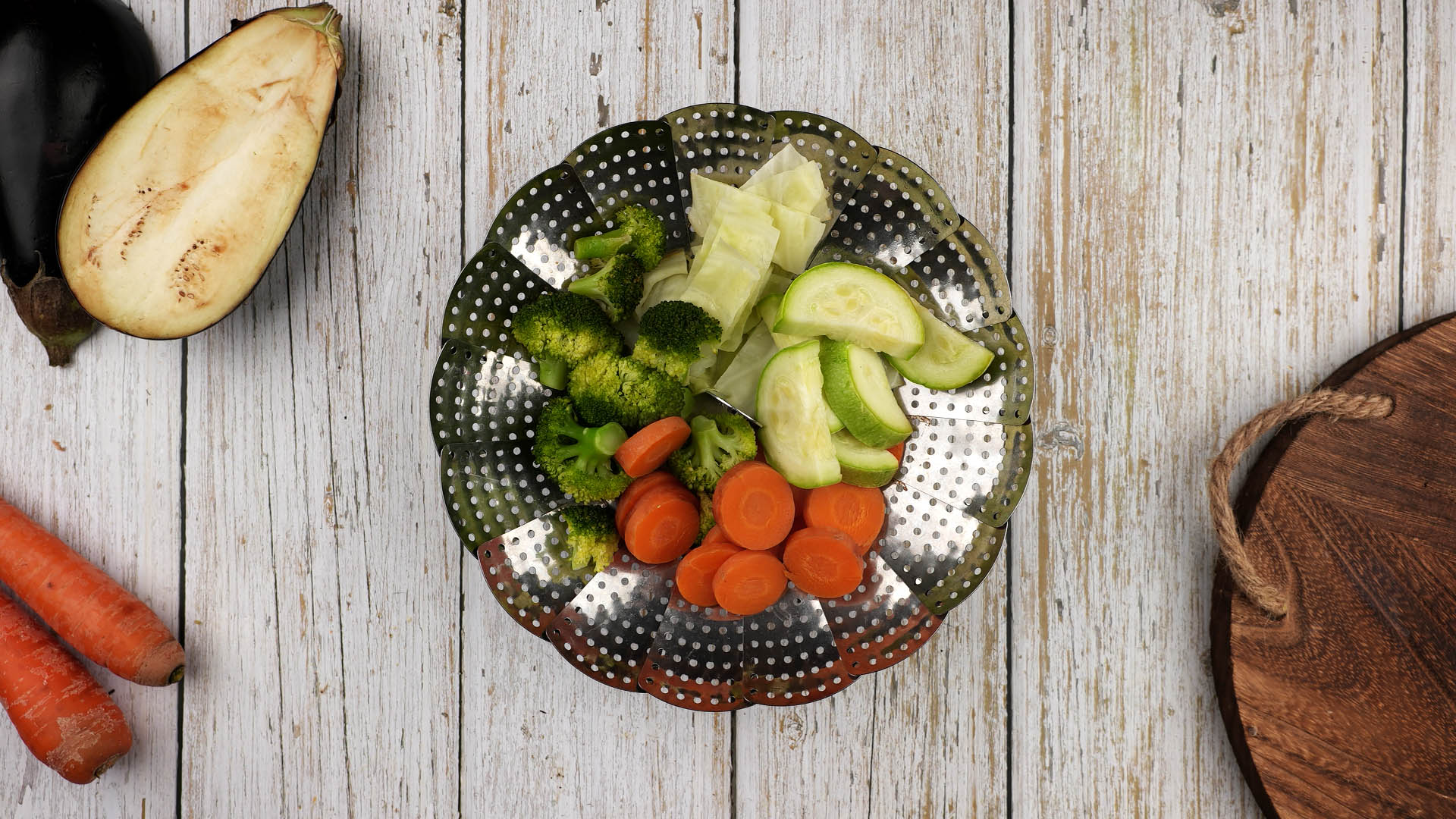Home>Gardening News and Trends>Latest News>How To Season Mixed Vegetables


Latest News
How To Season Mixed Vegetables
Modified: January 22, 2024
Discover the latest news on how to season mixed vegetables and elevate your culinary game. Explore different seasoning methods and create mouthwatering dishes.
(Many of the links in this article redirect to a specific reviewed product. Your purchase of these products through affiliate links helps to generate commission for Chicagolandgardening.com, at no extra cost. Learn more)
Table of Contents
Introduction
Adding a variety of vegetables to your meals not only enhances the nutritional value but also adds vibrant colors and flavors to your plate. Mixed vegetables are a versatile and delicious option to incorporate into your daily meals. Whether you’re preparing a stir-fry, a hearty soup, or a side dish, knowing how to season mixed vegetables can take your culinary creations to the next level.
Gathering a diverse selection of vegetables is the first step in creating a delicious mixed vegetable dish. From crunchy carrots to tender broccoli, the possibilities are endless. You can choose a combination of seasonal vegetables, such as bell peppers, zucchini, green beans, or even add a touch of sweetness with corn or peas. By experimenting with different vegetables, you can create a unique flavor profile and add a visually appealing element to your meals.
Once you have selected your vegetables, it’s important to properly prepare them before seasoning. Washing and chopping the vegetables ensures that they are clean and ready to be cooked. You can dice them into bite-sized pieces or julienne them for a more elegant presentation. The key is to have evenly sized pieces to ensure even cooking and consistent flavors throughout the dish.
Now comes the exciting part – seasoning the mixed vegetables. There are a plethora of seasoning options to choose from, depending on your personal taste preferences and the flavor profile you want to achieve. You can go for classic herbs and spices like garlic, oregano, and thyme, or experiment with more exotic flavors like curry powder, turmeric, or paprika. The choice is yours!
The seasoning method is also crucial in bringing out the best flavors in the vegetables. You can choose to lightly coat the vegetables with the seasoning before cooking, marinate them for a period of time to allow the flavors to penetrate, or even sprinkle the seasoning directly during the cooking process. Each method brings a different depth of flavor to the dish, so feel free to get creative and experiment.
Gathering Ingredients
When it comes to gathering the ingredients for your mixed vegetable dish, the options are endless. You have the freedom to choose from a wide variety of vegetables to create a vibrant and flavorful combination that suits your preferences. Here are some tips to help you gather the perfect ingredients for your mixed vegetable creation:
1. Seasonal Vegetables: Incorporating seasonal vegetables into your dish not only ensures freshness but also maximizes flavor and nutritional value. Visit your local farmer’s market or grocery store to discover the produce that is in season. From crisp asparagus in the spring to hearty root vegetables in the winter, each season offers a unique array of vegetables to choose from.
2. Colorful Variety: Aim for a visually appealing dish by selecting a variety of colorful vegetables. Bell peppers, carrots, broccoli, and cherry tomatoes can add a vibrant pop of color to your plate. Including a mix of green, red, and yellow vegetables not only makes the dish visually appealing but also provides a range of essential nutrients.
3. Texture Contrast: Consider the texture of the vegetables you choose. Combine crunchy and crisp vegetables like bell peppers, cabbage, or snow peas with softer and more tender ones like zucchini or mushrooms. The contrast in textures adds depth to your dish, making it more enjoyable to eat.
4. Flavor Balance: Choosing vegetables with different flavor profiles helps create a well-balanced dish. Some vegetables are naturally sweet, like carrots and corn, while others have a slight bitterness, such as Brussels sprouts and kale. By combining a mix of sweet, bitter, and savory vegetables, you can achieve a harmonious blend of flavors.
5. Personal Preference: Don’t forget to consider your personal preferences. If you have specific favorite vegetables, be sure to include them in your mixed vegetable dish. This will make the dish more enjoyable and cater to your individual tastes.
Remember, the key to a successful mixed vegetable dish is choosing fresh, high-quality ingredients. Take the time to handpick your vegetables, ensuring they are ripe, vibrant, and free from blemishes. This will enhance the flavors and overall presentation of your dish, guaranteeing a delicious and satisfying meal.
Preparing the Vegetables
Before diving into the seasoning process, it’s important to properly prepare the vegetables for optimal flavor and texture in your mixed vegetable dish. Follow these steps to ensure your vegetables are ready to be seasoned and cooked:
1. Washing: Start by washing all your vegetables thoroughly under cold running water. This helps remove any dirt, debris, or pesticide residue that may be present. Pat them dry with a clean kitchen towel or paper towels before proceeding.
2. Peeling and Trimming: For certain vegetables like carrots or potatoes, peeling the outer skin is necessary. Use a vegetable peeler or knife to remove the outer layer, ensuring a clean and smooth appearance. Additionally, trim off any woody stems, root ends, or tough sections from the vegetables.
3. Chopping and Cutting: Next, choose the appropriate method of cutting based on the desired shape and size for your dish. You can slice carrots and zucchini into coins, dice bell peppers into small pieces, or julienne green beans for longer strands. As you cut, try to keep the pieces as uniform as possible to ensure even cooking.
4. Blanching (Optional): Some recipes call for blanching certain vegetables before seasoning. Blanching involves briefly cooking the vegetables in boiling water, followed by immediate submersion in ice water to halt the cooking process. Blanching helps retain the vibrant colors and crisp texture of the vegetables.
5. Patting Dry: Once you have prepared and cut your vegetables, it’s important to pat them dry to remove excess moisture. Excess water on the vegetables can cause steaming instead of sautéing or roasting, resulting in a loss of texture and flavor.
By properly preparing your vegetables, you ensure that they are clean, fresh, and ready to absorb the flavors of your chosen seasonings. Taking the time to wash, peel, trim, and cut your vegetables allows for better control over the cooking process and helps produce a flavorful and visually appealing mixed vegetable dish.
Seasoning Options
Choosing the right seasoning can elevate the flavors of your mixed vegetables and turn a simple dish into a culinary delight. There are countless seasoning options available, allowing you to customize your dish to your own taste preferences. Here are some popular seasoning options to consider:
1. Herbs and Spices: Fresh or dried herbs and spices are a fantastic way to add depth and complexity to your mixed vegetable dish. Some classic choices include garlic, oregano, thyme, basil, rosemary, and parsley. Experiment with different combinations to find the perfect blend of flavors for your dish.
2. Seasoning Blends: Ready-made seasoning blends are a convenient option if you want a quick and easy solution. These blends often combine a variety of herbs, spices, and sometimes salt or sugar, providing a well-rounded flavor profile in one product. Look for blends like Italian seasoning, Cajun seasoning, or Chinese five-spice to add a unique twist to your mixed vegetables.
3. Sauces and Dressings: Another way to season your mixed vegetables is by using flavorful sauces and dressings. Opt for options like soy sauce, teriyaki sauce, balsamic glaze, or even a simple vinaigrette. These can add tanginess, sweetness, or savory notes to your dish, enhancing the overall flavor profile.
4. Citrus Zest: Brighten up your mixed vegetables with the addition of citrus zest. The zest of lemons, limes, or oranges adds a burst of freshness and tang to the dish. Simply grate the outer skin of the citrus fruit and sprinkle it over your cooked vegetables for an instant flavor boost.
5. Infused Oils: Infused oils, such as garlic-infused oil or chili-infused oil, can add an extra layer of flavor to your mixed vegetables. These oils are created by infusing them with herbs, spices, or aromatics, imparting their distinct taste into the dish. Drizzle a small amount over your cooked vegetables to enhance the overall flavor.
Remember, the seasoning options for your mixed vegetable dish are not limited to just one choice. Feel free to mix and match different herbs, spices, and sauces to create your own unique flavor combinations. Don’t be afraid to get creative in the kitchen and let your taste buds be your guide!
Seasoning Method
Once you have gathered your desired seasoning options, it’s time to decide on the best method for incorporating those flavors into your mixed vegetable dish. The seasoning method you choose can greatly impact the overall taste and texture of the vegetables. Here are a few popular seasoning methods to consider:
1. Pre-seasoning: In this method, you can coat the mixed vegetables with the seasoning mixture before cooking. Simply toss the vegetables with the herbs, spices, or sauces to ensure that the flavors evenly distribute across the vegetables. This method is particularly useful when roasting or grilling the vegetables, allowing the flavors to infuse and develop during the cooking process.
2. Marinating: For a more intense flavor, marinating the vegetables before cooking can be a great option. Prepare a marinade using your choice of herbs, spices, oils, and acids like lemon juice or vinegar. Allow the vegetables to soak in the marinade for at least 30 minutes or longer in the refrigerator. Marinating helps the vegetables absorb the flavors more deeply and creates a more pronounced taste when cooked.
3. Sprinkling during Cooking: Another approach is to sprinkle the seasoning directly onto the vegetables as they cook. This method works well when sautéing or stir-frying. As the vegetables heat up, the seasonings blend with the natural juices of the vegetables, creating a delightful combination of flavors. Remember to add the seasoning gradually, tasting as you go, to ensure you achieve the desired taste without overpowering the vegetables.
4. Adjusting Seasoning at the End: Taste your cooked mixed vegetables and adjust the seasoning accordingly before serving. This step allows you to fine-tune the flavors and make any necessary adjustments to suit your personal taste preferences. You can sprinkle a bit more salt, add a dash of your favorite spice, or drizzle with a finishing sauce to enhance the overall taste of the dish.
Keep in mind that the seasoning method you choose will depend on the cooking technique you plan to use and the desired level of flavor intensity. Experiment with different methods to find the one that best suits your taste buds and brings out the best in your mixed vegetables.
Cooking the Mixed Vegetables
Now that you have prepared and seasoned your mixed vegetables, it’s time to cook them to perfection. The cooking method you choose will depend on the desired texture and flavor of the vegetables. Here are some popular cooking methods for mixed vegetables:
1. Sautéing: Sautéing vegetables involves cooking them quickly in a hot skillet or sauté pan with a small amount of oil or butter. This method works well for tender vegetables like bell peppers, zucchini, and mushrooms. Heat the oil or butter over medium-high heat, add the seasoned vegetables, and cook for a few minutes until they are crisp-tender, stirring occasionally to ensure even cooking.
2. Roasting: Roasting mixed vegetables in the oven brings out their natural sweetness and adds a delightful caramelized flavor. Preheat your oven to the desired temperature, usually around 400°F (200°C). Spread the seasoned vegetables evenly on a baking sheet and roast for 20-25 minutes, or until they are tender and slightly browned. Make sure to toss them halfway through cooking to ensure they cook evenly.
3. Steaming: Steaming is a healthier option that preserves the natural color, texture, and nutrients of the mixed vegetables. Fill a pot with a small amount of water and bring it to a boil. Place a steamer basket or colander in the pot, ensuring that it doesn’t touch the water. Add the seasoned vegetables to the steamer basket and cover with a lid. Steam the vegetables for a few minutes until they are crisp-tender. Be careful not to overcook them, as this can lead to a mushy texture.
4. Stir-Frying: Stir-frying is a popular cooking method in Asian cuisine that involves quickly cooking the mixed vegetables in a hot wok or skillet with a small amount of oil. Heat the oil over high heat, add the seasoned vegetables, and stir-fry for a few minutes, tossing them constantly until they are crisp-tender. The high heat allows for a quick cooking time, preserving the vibrant colors and crunchy texture of the vegetables.
5. Grilling: Grilling adds a smoky and charred flavor to the mixed vegetables, making it a perfect choice for outdoor cooking or a barbecue. Preheat your grill to medium-high heat and lightly oil the grates. Place the seasoned vegetables directly on the grill and cook for a few minutes on each side until they are slightly charred and tender. Grilling brings out the natural sweetness of the vegetables and adds a delicious smoky flavor.
Remember to keep a close eye on the vegetables as they cook, tasting for desired doneness and adjusting the cooking time accordingly. Whether you choose to sauté, roast, steam, stir-fry, or grill, the cooking method should highlight the flavors and textures of your mixed vegetables, resulting in a delicious and satisfying dish that can be enjoyed as a main course or a flavorful side.
Serving Suggestions
Once your mixed vegetables are cooked to perfection, it’s time to present them in a way that is enticing and enjoyable. Here are some creative serving suggestions to enhance the overall dining experience:
1. Side Dish: Serve your seasoned mixed vegetables as a flavorful side dish alongside a main course. Pair them with grilled chicken, roasted fish, or a juicy steak. The vibrant colors and varied textures of the vegetables will add a visually pleasing element to your plate.
2. Stir-Fry: Use your seasoned mixed vegetables as a base for a delicious stir-fry. Add protein such as tofu, shrimp, or sliced chicken, and toss them together in a wok or skillet. Finish with a drizzle of soy sauce or a stir-fry sauce of your choice for a complete and satisfying meal.
3. Pasta Primavera: Incorporate your seasoned mixed vegetables into a pasta dish for a burst of color and flavor. Sauté the vegetables and toss them with al dente pasta, olive oil, garlic, and grated Parmesan cheese. This dish is not only delicious but also a great way to sneak in some extra veggies.
4. Buddha Bowl: Create a healthy and vibrant Buddha bowl by layering your seasoned mixed vegetables with grains such as quinoa or brown rice, and proteins like grilled tofu or chickpeas. Top it off with a drizzle of tahini sauce or your favorite dressing for a nutritious and visually appealing meal in a bowl.
5. Vegetable Medley: Combine your seasoned mixed vegetables with other cooked or roasted vegetables to create a colorful and flavorful vegetable medley. Serve it as a standalone dish or as a nutritious accompaniment to any meal. This combination works well as a side dish for a holiday feast or a Sunday family dinner.
6. Salad: Turn your seasoned mixed vegetables into a refreshing salad. Toss them with lettuce, baby spinach, or arugula, and add a zesty dressing like lemon vinaigrette or balsamic glaze for a burst of flavor. This salad can be enjoyed as a light lunch option or as a side dish for a summer barbecue.
Remember to garnish your dish with some fresh herbs like parsley or basil for an added pop of color and freshness. Don’t be afraid to get creative and try out different serving suggestions. The versatility of seasoned mixed vegetables allows you to create a wide range of delicious and visually appealing dishes that are sure to satisfy both your taste buds and your eyes.
Conclusion
Seasoning mixed vegetables is a wonderful way to transform a simple side dish into a flavorful and satisfying culinary masterpiece. By gathering a variety of fresh vegetables, properly preparing them, and using the right seasoning methods, you can create a dish that is both visually appealing and bursting with delicious flavors.
Experiment with different herbs, spices, sauces, and seasoning blends to find your perfect flavor combinations. Whether you choose to sauté, roast, stir-fry, steam, or grill your mixed vegetables, each cooking method brings out unique textures and tastes, allowing you to customize your dish to your liking.
Remember to consider the seasonal availability of vegetables, the color and texture contrasts, and your personal preferences when gathering ingredients for your mixed vegetable dish. Prepare the vegetables with care, ensuring they are cleaned, cut, and dried properly before seasoning.
Use your seasoning options wisely, either by pre-seasoning, marinating, sprinkling during cooking, or adjusting the seasoning at the end. Each method brings its own flavor profile and allows the vegetables to absorb the seasonings, enhancing their taste and aroma.
Finally, explore various serving suggestions to showcase your seasoned mixed vegetables. Whether as a side dish, part of a stir-fry, pasta dish, or salad, the possibilities are endless. Let your creativity guide you as you plate your creation and garnish it with fresh herbs or a sprinkle of cheese.
So go ahead, get cooking, and savor the wonderful flavors and textures that come from perfectly seasoned mixed vegetables. With these tips and techniques, you’ll be able to enjoy a delicious, nutritious, and visually appealing dish that will please both your palate and your guests.







